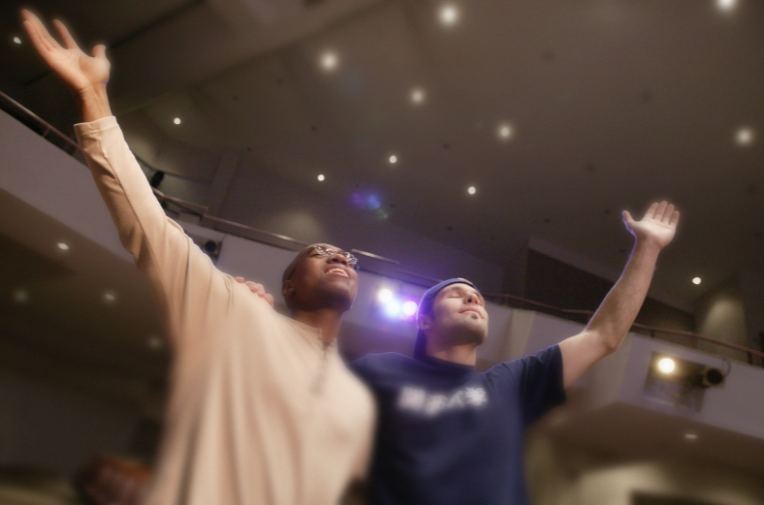DownRiver UMC celebrated its first worship service as a new church start on July 7, 2013, with 186 people in attendance. DownRiver is a Vital Merger of four churches in the Detroit area: Lincoln Park First, Allen Park Trinity, Lincoln Park Dix, and Taylor West Mound United Methodist Churches. The average worship attendance of these four churches had ranged from 29 to 66 in the first six months of 2012. These four churches voted to become a new church in December 2012.
As a Vital Merger, they made commitments to each other:
- Sell all church buildings and relocate to a new location
- Worship in a neutral location from the day of the official merger
- Reset the new congregation’s focus on the mission field and begin new ministries to reach the new mission field
- Receive a pastor that has been assessed and trained as a church planter
- Choose a name that is not a part of the name of any of the merging churches.
Members of DownRiver UMC are living into the commitments that they have made.
New Investment
They are selling all four church buildings. One is already sold, and another has an offer. Of the three parsonages that the churches owned, one has been sold, there is an offer on the second, and the remaining parsonage will be retained for the new church. After each church held special worship services the last week of June to celebrate their legacy as a congregation, they began worshipping in July at Gerisch Middle School in Southgate (a suburb of Detroit). They have rented this school, which was closed at the end of the 2013 school year, as a seven-day-a-week facility for the next year.
DownRiver has developed new Mission and Vision Statements as they take a fresh look at their new mission field, and they will begin developing new ministries and programs that will reach this mission field. The new pastor of DownRiver UMC is the Rev. Dr. Margie Bryce (shown above sharing a children’s sermon). Dr. Bryce is a trained and assessed church planter, and currently in the New Church Planter’s Academy, a two-year training experience focused on starting healthy new churches.
The word “merger,” creates anxiety because it implies uncertain change. Some people view the idea of a merger as a hostile takeover with winners and losers. Still others immediately see issues involving loss of identity. Whether the term is applied to a business or faith community, there’s fear that uncomfortable change is coming. After a merger, things may be different. A business may offer different services or start a product line. Churches may meet in a new location. Any kind of merger requires foundational change that on the surface may feel impersonal at first.
Merger Math
Church mergers take various forms. Traditionally, the most common form has been two or more churches deciding to consolidate their resources by moving into the best facility they already own and retaining only one pastor. These mergers rarely bear the fruitful ministry anticipated by the merging churches.
While there may be occasional exceptions, typically the resulting congregation from this form of merger will eventually lose participation and decrease in attendance to the size of the larger church before the merger. So instead of 1+3=4, you get 1+3+much drama=3. Often, the lack of fruitfulness and growth in traditional mergers stems from its primary motivation: the need to survive rather than the need to further its mission.
Instead of consolidating resources, the Vital Merger strategy creates a new church—a healthy, growing, new-church-start with a fresh focus on the mission field and new ways of doing ministry. Using a Biblical metaphor, the traditional merger is attempting to pour new wine into old wineskins. The Vital Merger, on the other hand, creates new wine that is poured into a new wineskin. A Vital Merger congregation is a new work.
A New Thing
In her first sermon at this new church, Dr. Bryce encouraged the congregation, saying, “God is doing NEW THING at DownRiver UMC … leading you; making a way in desert. You have said Yes to God. Yes to saying good-bye to buildings; buildings that have served you well. Buildings full of history and stories. You have said yes to walking out into the unknown. Yes to worshipping with folks you don’t quite know yet. Yes to putting God’s concerns first over everything else.”
To learn more about Vital Mergers read Vital Merger: A New Church Start Approach that Joins Church Families Together, or go to www.vitalmerger.com. Vital Merger is a practical handbook that outlines the key elements necessary for a Vital Merger and provides instructions for exploring, beginning, and walking through the Vital Merger process. The advice, examples, and stories are taken from actual churches that have merged—including processes and practices that have and have not worked well. The stories from these churches have informed and infused the process with authentic insight and witness.
